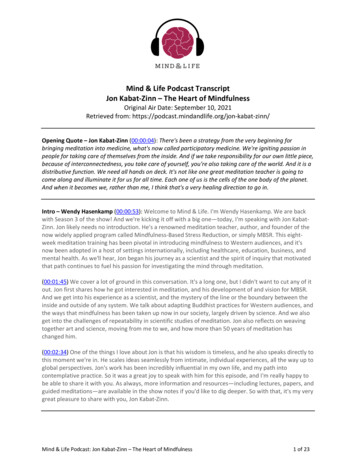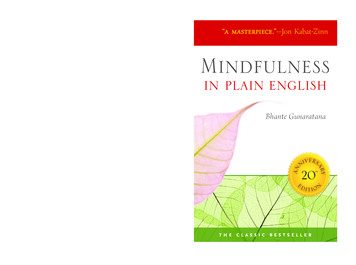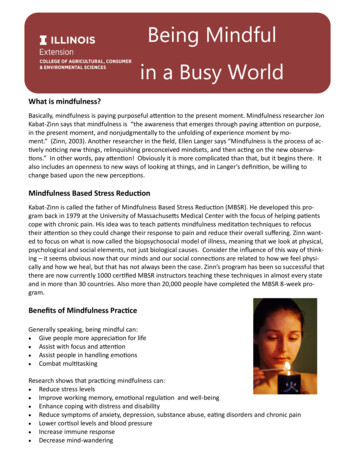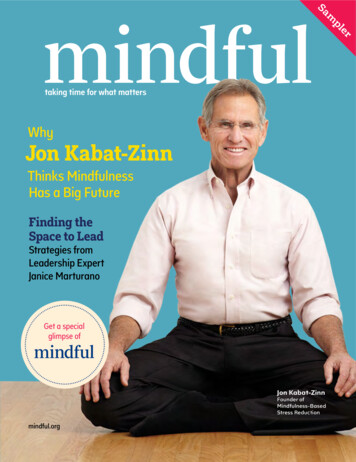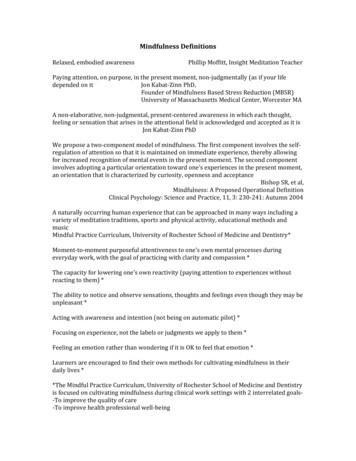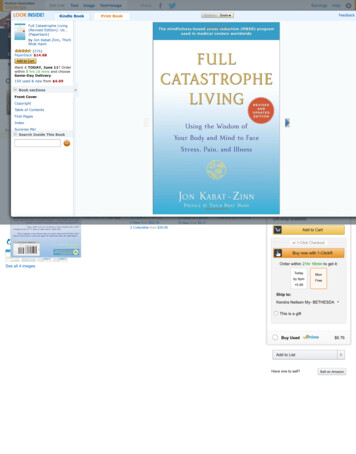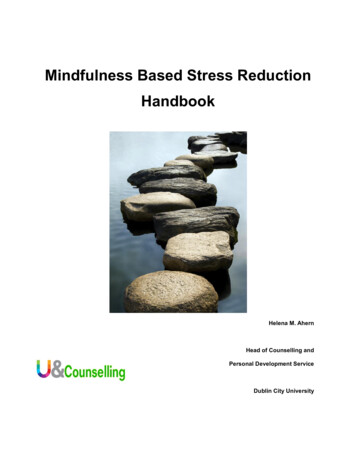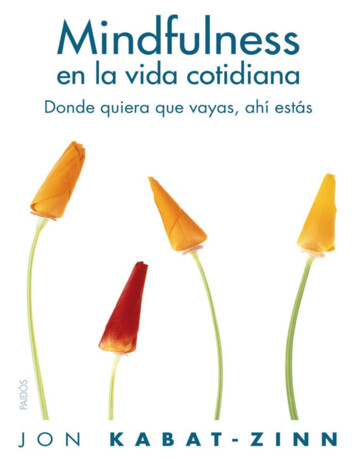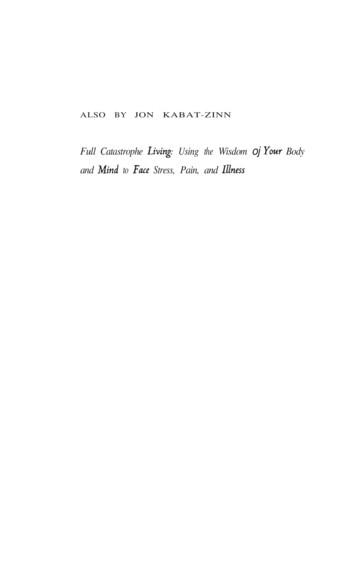
Transcription
ALSOBYJONKABAT-ZINNFull Catastrophe Living: Using the Wisdom oj Your Bodyand Mind to Face Stress, Pain, and Illness
Wherever You Go,There You Are
Wherever You Go,There You Are*Mindfulness Meditationin Everyday Life*Jon Kabat-Zinn HYPERIONINEWYORK
Copyright 1994 Jon Kabat-ZinnAll rights reserved. No part of this book may be used or reproducedin any manner whatsoever without written permission of the Publisher.Printed in the United States of America. For information addressHyperion. 114 Fifth Avenue, New York, New York 10011.Reprint permissions appear on page 277.Library of Congress Cataloging-in-Publicadon DataKabat-Zinn, Jon.Wherever you go. there you are : mindfulness meditationin everyday life / Jon Kabat-Zinn. -p.1st ed.em.ISBN 0-7868-8070-8I. Meditation. 1. Attention.1. Tide.II. Title: Mindfulness meditation in everyday life.BF637.M4K1.319941554042-dc2093-1.4 38First Paperback Edition10987642C1P
For Myla, Will, Naushon, and Serena,wherever you go
I would like to thank Myla Kabat-Zinn, Sarah Doering, LarryRosenberg, John Miller, Dani lle Levi Alvares, Randy Paulsen,Martin Diskin, Dennis Humphrey, and Ferris Urbanowski forreading early drafts of the manuscript and giving me theirvaluable insights and encouragement. My deep appreciation toTrudy and Barry Silverstein for the use of Rocky Horse Ranchduring an intensive period of early writing, and to Jason andWendy Cook for Western adventures during those wonderfuldays. Profound gratitude to my editors, Bob Miller and MaryAnn Naples, for their deep commitment to excellence and thepleasure of working with them. I thank them, the Hyperionfamily, literary agent, Patricia Vander Leun, Dorothy Schmiderer Baker, book designer, and Beth Maynard, artist, for the careand attention they gave to the birthing of this book.
ContentsIntroductionPAR TON EXt11The Bloom oj the Present MomentIWhat Is Mindfulness?3Simple But Not Easy8StoppingI IThis Is It14Capturing Your Moments17Keeping the Breath in Mind18Practice, Practice, Practice2 IPractice Does Not Mean Rehearsal22You Don't Have to Go Out of Your Way to Practice24Waking Up26Keeping It Simple29You Can't Stop the Waves But You Can Learn to Surf30Can Anybody Meditate?33In Praise of Non-Doing35The Non-Doing Paradox38Non-Doing in Action40Doing Non-Doing44Patience47ix
Letting GoNon-JudgingTrustGenerosityYou Have to Be Strong Enough to Be WeakVoluntary SimplicityConcentrationVisionMeditation Develops Full Human BeingsPractice,as a PathMeditation: Not to Be ConfUsed withPositive ThinkingGoing InsidePAR TTWOThe Heart oj PracticeSitting MeditationTaking Your SeatDignityPostureWhat to Do with Your HandsComing Out of MeditationHow Long to Practice?No Right WayA What-Is-My-Way? MeditationThe Mountain Meditationx
The Lake Meditation14 1Walking Meditation145Standing Meditation149Lying-Down Meditation151Getting Your Body Down on the Floor at LeastOnce a Day157Not Practicing Is Practicing160Loving Kindness Meditation162PAR T T H R E EIn the Spirit oj Minij-ulness17 1Sitting by Fire173Harmony176Early Morning179Direct Contact18 5Is There Anything Else You Would Like to Tell Me?188Your Own Authority19 IWherever You Go, There You Are195Going Upstairs20 ICleaning the Stove While Listening to Bobby McFerrin204What Is My Job on the Planet with a Capital J?206Mount Analogue2 1IInterconnectedness2 13Non-Harming-Ahimsa2 17Karma220Wholeness and Oneness226xi
Eachness and SuchnessWhat Is This?SelfingAngerCat-Food LessonsParenting As PracticeParenting TwoSome Pitfalls Along the PathIs Mindfulness Spiritual?Mindfulness Meditation Practice TapesSERIESISERIES2ORDERFORMxii
IntroductionGuess what? When it comes right down to it, wherever you go,there you are. Whatever you wind up doing, that's what you'vewound up doing. Whatever you are thinking right now, that'swhat's on your mind. Whatever has happened to you, it hasalready happened. The important question is, how are you goingto handle it? In other words, "Now what?"Like it or not, this moment is all we really have to work with.Yet we all too easily conduct our lives as if forgetting momentarily that we are here, where we already are, and that we are inwhat we are already in. In every moment, we find ourselves atthe crossroad of here and now. But when the cloud of forgetfulness over where we are now sets in, in that very moment we getlost. "Now what?" becomes a real problem.By lost, I mean that we momentarily lose touch with ourselvesand with the full extent of our possibilities. Instead, we fall intoa robotlike way of seeing and thinking and doing. In thosemoments, we break contact with what is deepest in ourselvesand affords us perhaps our greatest opportunities for creativity,learning, and growing. If we are not careful, those cloudedmoments can stretch out and become most of our lives.To allow ourselves to be truly in touch with where we alreadyare, no matter where that is, we have got to pause in ourxiii
experience long enough to let the present moment sink in; longenough to actually feel the present moment, to see it in itsfullness, to hold it in awareness and thereby come to know andunderstand it better. Only then can we accept the truth of thismoment of our life, learn from it, and move on. Instead, it oftenseems as if we are preoccupied with the past, with what hasalready happened, or with a future that hasn't arrived yet. Welook for someplace else to stand, where we hope things will bebetter, happier, more the way we want them to be, or the waythey used to be. Most of the time we are only partially awareof this inner tension, if we are aware of it at alL What is more,we are also only partially aware at best of exactly what we aredoing in and with our lives, and the effects our actions and, moresubtly, our thoughts have on what we see and don't see, whatwe do and don't do.For instance, we usually fall, quite unawares, into assumingthat what we are thinking-the ideas and opinions that weharbor at any given time-are "the truth" about what is "outthere" in the world and "in here" in our minds. Most of thetime, it just isn't so.We pay a high price for this mistaken and unexaminedassumption, for our almost willful ignoring of the richness ofour present moments. The fallout accumulates silently, coloringour lives without our knowing it or being able to do somethingabout it. We may never quite be where we actually are, neverquite touch the fullness of our possibilities. Instead, we lockxiv
ourselves into a personal fiction that we already know who weare, that we know where we are and where we are going, that weknow what is happening-all the while remaining enshroudedin thoughts, fantasies, and impulses, mostly about the past andabout the future, about what we want and like, and what we fearand don't like, which spin out continuously, veiling our direction and the very ground we are standing on.The book you have in your hands is about waking up fromsuch dreams and from the nightmares they often turn into. Notknowing that you are even in such a dream is what the Buddhistscall "ignorance," or mindlessness. Being in touch with this notknowing is called "mindfulness." The work of waking up fromthese dreams is the work of meditation, the systematic cultivation of wakefulness, of present-moment awareness. This wakingup goes hand in hand with what we might call "wisdom," aseeing more deeply into cause and effect and the interconnected ness of things, so that we are no longer caught in a drearndictated reality of our own creation. To find our way, we willneed to pay more attention to this moment. It is the only timethat we have in whi h to live, grow, feel, and change. We willneed to become more aware of and take precautions against theincredible pull of the Scylla and Charybdis of past and future,and the dreamworld they offer us in place of our lives.When we speak of meditation, it is important for you toknow that this is not some weird cryptic activity, as our popularculture might have it. It does not involve becoming some kindxv
of zombie, vegetable, self-absorbed narcissist, navel gazer,"space cadet," cultist, devotee, mystic, or Eastern philosopher.Meditation is simply about being yourself and knowing something about who that is. It is about coming to realize that youare on a path whether you like it or not, namely, the path thatis your life. Meditation may help us see that this path we callour life has direction; that it is always unfolding, moment bymoment; and that what happens now, in this moment, influences what happens next.If wh.at happens now does influence what happens next, thendoesn't it makes sense to look around a bit from time to timeso that you are more in touch with what is happening now, sothat you can take your inner and outer bearings and perceivewith clarity the path that you are actually on and the directionin which you are going? If you do so, maybe you will be in abetter position to chart a course for yourself that is truer to yourinner being-a soul path, a path with heart, your path with acapital P. If not, the sheer momentum of your unconsciousnessin this moment just colors the next moment. The days, months,and years quickly go by unnoticed, unused, unappreciated.It is all too easy to remain on something of a fog-enshrouded,slippery slope right into our graves; or, in the fog-dispellingclarity which on occasion precedes the moment of death, towake up and realize that what we had thought all those yearsabout how life was to be lived and what was important were atbest unexamined half-truths based on fear or ignorance, onlyxvi
our own life-limiting ideas, and not the truth or the way our lifehad to be at all.No one else can do this job of waking up for us, althoughour family and friends do sometimes try desperately to getthrough to us, to help us see more clearly or break out of ourown blindnesses. But waking up is ultimately something ·thateach one of us can only do for ourselves. When it comes downto it, wherever you go, there you are. It's your life that is unfolding.At the end of a long life dedicated to teaching mindfulness,the Buddha, who probably had his share of followers who werehoping he might make it easier for them to find their own paths,summed it up for his disciples this way: "Be a light untoyourself"In my previous book, Full Catastrophe Living, I tried to make thepath of mindfulness accessible to mainstream Americans so thatit would not feel Buddhist or mystical so much as sensible.Mindfulness has to do above all with attention and awareness,which are universal human qualities. But in our society, we tendto take these capacities for granted and don't think to developthem systematically in the service of self-understanding andwisdom. Meditation is the process by which we go about deepening our attention and awareness, refining them, and puttingthem to greater practical use in our lives.Full Catastrophe Living can be thought of as a navigational chart,intended for people facing physical or emotional pain or reelingxvii
from the effects of too much stress. The aim was to challengethe reader to realize, through his or her direct experiences ofpaying attention to things we all so often ignore, that theremight be very real reasons for integrating mindfulness into thefabric of one's life.Not that I was suggesting that mindfulness is some kind ofa cureall or dimestore solution to life's problems. Far from it.I don't know of any magical solutions and, frankly, I am notlooking for one. A full life is painted with broad brush strokes.Many p 1-ths can lead to understanding and wisdom. Each of ushas different needs to address and things worth pursuing overthe course of a lifetime. Each of us has to chart our own course,and it has to fit what we are ready for.You certainly have to be ready for meditation. You have tocome to it at the right time in your life, at a point where youare ready to listen carefully to your own voice, to your ownheart, to your own breathing-to just be present for them andwith them, without having to go anywhere or make anythingbetter or different. This is hard work.I wrote Full Catastrophe Living thinking of the people referredto us as patients in our stress reduction clinic at the Universityof Massachusetts Medical Center. I was moved to do so by theremarkable transformations in mind and body that many peoplereport as they put aside trying to change the severe problemsthat brought them to the clinic in the first place, and engage overan eight-week period in the intensive discipline of openingxviii
and listening that characterizes the practice of mindfulness.As a navigational chart, Full Catastrophe Living hadtosupplyenough detail so that someone in significant need could plot hisor her own course with care. It had to speak to the pressingneeds of people with serious medical problems and chronicpain, as well as to those suffering in different kinds of stressfulsituations. For these reasons, it had to include a good deal ofinfonnation on stress and illness, health and healing, as well asextensive instructions on how to meditate.This book is different. It is meant to provide brief and easyaccess to the essence of mindfulness meditation and its applications. for people whose lives mayor may not be dominated byimmediate problems of stress, pain, and illness. It is offeredparticularly for those who resist structured programs and forpeople who don't like to be told what to do but are curiousenough about mindfulness and its relevance to try to piecethings together for themselves with a few hints and suggestionshere and there.At the same time, this book is also offered to those who arealready practicing meditation and wish to expand, deepen, andreinforce their commitment to a life of greater awareness andinsight. Here, in brief chapters, the focus is on the spirit ofmindfulness, both in our fonnal attempts at practice and in ourefforts to bring it into all aspects of our daily lives. Each chapteris a glimpse through one face of the multifaceted diamond ofmindfulness. The chapters are related to each other by tinyxix
rotations of the crystal. Some may sound similar to others, buteach facet is also different, unique.This exploration of the diamond of mindfulness is offeredfor all those who would chart a course toward greater sanity andwisdom in their lives. What is required is a willingness to lookdeeply at one's present moments, no matter what they hold, ina spirit of generosity, kindness toward oneself, and opennesstoward what might be possible.Part One explores the rationale and background for taking onor deepening a personal practice of mindfulness. It challengesthe reader to experiment with introducing mindfulness into hisor her life in a number of different ways. Part·Two exploressome basic aspects of formal meditation practice. Formal practice refers to specific periods of time in which we purposefullystop other activity and engage in particular methods of cultivating mindfulness and concentration. Part Three explores a rangeof applications and perspectives on mindfulness. Certain chapters in all three parts end with explicit suggestions for incorporating aspects of both formal and informal mindfulnesspractice into one's life. These are found under the headinguTR Y. "This volume contains sufficient instructions to engageIIImeditation practice on one's own, without the use of othermaterials or supports. However, many people find it helpful touse audiotapes in the beginning to support the daily disciplineof a formal meditation practice, and to guide them in thexx
instructions until they get the hang of it and wish to practice ontheir own. Others find that even after years of practice, it ishelpful on occasion to make use of tapes. To this end, a newseries of mindfulness meditation practice tapes (Series 2) hasbeen prepared in conjunction with this book. These tapes rangein length from ten minutes to half an hour; they give the readerwho is new to mindfulness practice a range of techniques toexperiment with, as well as room to decide what length offormal practice is appropriate for a given time and place. TheSeries2tapes are listed in the order form at the back of thisbook, along with the 45-minute tapes from Seriesaccompany Full Catastrophe Living.xxiIwhich
Part OneThe Bloom oj the Present MomentOnly that day dawns to which we are awake.HEN R YDAVIDTHO REAu, Walden
, - :What Is Mindfulness?:1Id!l' iii:Mindfulness is an ancient Buddhist practice which has profoundrelevance for our present-day lives. This relevance has nothingto do with Buddhism per se or with becoming a Buddhist, butit has everything to do with waking up and living in harmonywith oneself and with the world. It has to do with examiningwho we are, with questioning our view of the world and ourplace in it, and with cultivating some appreciation for thefullness of each moment we are alive. Most of all, it hastodowith being in touch.From the Buddhist perspective, our ordinary waking stateof consciousness is seen as being severely limited and limiting, resembling in many respects an extended dream ratherthan wakefulness. Meditation helps us wake up from thissleep of automaticity and unconsciousness, thereby making itpossible for us to live our lives with access to the full spectrum of our conscious and unconscious possibilities. Sages,yogis, and Zen masters have been exploring this territory systematically for thousands of years; in the process they havelearned something which may now be profoundly beneficialin the West to counterbalance our cultural orientation toward controlling and subduing nature rathet than honoringthat we are an intimate part of it. Their collective experience3
suggests that by investigating inwardly our own nature as beings and, particularly, the nature of our own minds throughcareful and systematic self-observation, we may be able to livelives of greater satisfaction, harmony, and wisdom. It alsooffers a view of the world which is complementary to thepredominantly reductionist and materialistic one currentlydominating Western thought and institutions. But this viewis neither particularly "Eastern" nor mystical. Thoreau sawthe same problem with our ordinary mind state in New England i 1846 and wrote with great passion about its unfortunate consequences.Mindfulness has been called the heart of Buddhist meditation. Fundamentally, mindfulness is a simple concept. Its powerlies in its practice and its applications. Mindfulness meanspaying attention in a particular way: on purpose, in the presentmoment, and nonjudgmentally. This kind of attention nurturesgreater awareness, clarity, and acceptance of present-momentreality. It wakes us up to the fact that our lives unfold only inmoments. If we are not fully present for many of those moments, we may not only miss what is most valuable in our livesbut also fail to realize the richness and the depth of our possibilities for growth and transformation.A diminished awareness of the present moment inevitablycreates other problems for us as well through our unconsciousand automatic actions and behaviors, often driven by deepseatedfears and insecurities. These problems tend to build over time4
if they are not attended to and can eventually leave us feelingstuck and out of touch. Over time, we may lose confidence inour ability to redirect our energies in ways that would lead togreater satisfaction and happiness, perhaps even to greaterhealth.Mindfulness provides a simple but powerful route for gettingourselves unstuck, back into touch with our own wisdom andvitality. It is a way to take charge of the direction and qualityof our own lives, including our relationships within the family,our relationship to work and to the larger world and planet, andmost fundamentally, our relationship with ourself as a person.The key to this path, which lies at the root of Buddhism,Taoism, and yoga, and which we also find in the works ofpeople like Emerson, Thoreau, and Whitman, and in NativeAmerican wisdom, is an appreciation for the present momentand the cultivation of an intimate relationship with it througha continual attending to it with care and discernment. It is thedirect opposite of taking life for granted.The habit of ignoring our present moments in favor of othersyet to come leads directly to a pervasive lack of awareness of theweb of life in which we are embedded. This includes a lack ofawareness and understanding of our own mind and how itinfluences our perceptions and our actions. It severely limits ourperspective on what it means to be a person and how we areconnected to each other and to the world around us. Religionhas traditionally been the domain of such fundamental inquiries5
within a spiritual framework, but mindfUlness has little to dowith religion, except in the most fundamental meaning of theword, as an attempt to appreciate the deep mystery of being aliveand to acknowledge being vitally connected to all that exists.When we commit ourselves to paying attention in an openway, without falling prey to our own likes and dislikes, opinionsand prejudices, projections and expectations, new possibilitiesopen up and we have a chance to free ourselves from thestraitjacket of unconsciousness.I like to think of mindfUlness simply as the art of consciousliving. You don't have to be a Buddhist or a yogi to practice it.In fact, if you know anything about Buddhism, you will knowthat the most important point is to be yourself and not try tobecome anything that you are not already. Buddhism is fUndamentally about being in touch with your own deepest nature andletting it flow out of you unimpeded. It has to do with wakingup and seeing things as they are. In fact, the word "Buddha"simply means one who has awakened to his or her own truenature.So, mindfUlness will not conflict with any beliefs or traditions-religious or for that matter scientific-nor is it trying tosell you anything, especially not a new belief system or ideology.It is simply a practical way to be more in touch with the fullnessof your being through a systematic process of self-observation,self-inquiry, and mindful action. There is nothing cold, analytical, or unfeeling about it. The overall tenor of mindfUlness6
practice is gentle, appreciative, and nurturing. Another way tothink of it would be "heartfulness."*A student once said: "When I was a Buddhist, it drove myparents and friends crazy, but when I am a buddha, nobody is upset at all."7
\ :. :Simple But Not EasyWhile it may be simple to practice mindfulness, it is not necessarily easy. Mindfulness requires effort and discipline for thesimple reason that the forces that work against our being mindful, namely, our habitual unawareness and automaticity, areexceedingly tenacious. They are so strong and so much out ofour consciousness that an inner commitment and a certain kindof work are necessary justtokeep up our attempts ·to captureour moments in awareness and sustain mindfulness. But it is anintrinsically satisfYing work because it puts us in touch withmany aspects of our lives that are habitually overlooked and lostto us.It is also enlightening and liberating work. It is enlighteningin that it literally allows us to see more clearly, and thereforecome to understand more deeply, areas in our lives that we wereout of touch with or unwilling to look at. This may includeencountering deep emotions-such as grief, sadness, woundedness, anger, and fear-that we might not ordinarily allow ourselves to hold in awareness or express consciously. Mindfulnesscan also help us to appreciate feelings such as joy, peacefulness,and happiness which often go by fleetingly and unacknowledged. It is liberating in that it leads to new ways of being inour own skin and in the world, which can free us from the ruts8
we so often fall into. It is empowering as well, because payingattention in this way opens channels to deep reservoirs ofcreativity, intelligence, imagination, clarity, determination,choice, and wisdom within us.We tend to be particularly unaware that we are thinkingvirtually all the time. The incessant stream of thoughts flowingthrough our minds leaves us very little respite for inner quiet.And we leave precious little room for ourselves anyway just tobe, without having to run around doing things all the time. Ouractions are all too frequently driven rather than undertaken inawareness, driven by those perfectly ordinary thoughts and impulses that run through the mind like a coursing river, if not awaterfall. We get caught up in the torrent and it winds upsubmerging our lives as it carries us to places we may not wishtogo and may not even realize we are headed for.Meditation means learning how to get out of this current, sitby its bank and listen to it, learn from it, and then use itsenergies to guide us rather than to tyrannize us. This processdoesn't magically happen by itself. It takes energy. We call theeffort to cultivate our ability to be in the present moment"practice" or "meditation practice."*9
Question: How can I set right a tangle which is entirelybelow the level of my consciousness?Nisargadatta: By being with youtself . . . by watchingyourself in your daily life with alert interest, with theintention to understand rather than to judge, in fullacceptance of whatever may emerge, because it is there,you encourage the deep to come to the surface andenrich your life and consciousness with its captiveenergies. This is the great work of awareness; itremoves obstacles and releases energies by understanding the nature of life and mind. Intelligence isthe door to freedom and alert attention is the motherof intelligence.N I S A R GAD A T TAM A H A RAJ.10I Am nat
People think of meditation as some kind of special activity, butthis is not exactly correct. Meditation is simplicity itself. As ajoke, we sometimes say: "Don't just do something, sit there."But meditation is not just about sitting, either. It is aboutstopping and being present, that is all. Mostly we run arounddoing. Are you able to come to a stop in your life, even for onemoment? Could it be this moment? What would happen if youdid?A good way to stop all the doing is to shift into the "beingmode" for a moment. Think of yourself as an eternalwitness, as timeless. Just watch this moment, without trying to change it at all. What is happening? What do youfeel? What do you see? What do you hear?The funny thing about stopping is that as soon as you doit, here you are. Things get simpler. In some ways, it's asif you died and the world continued on. If you did die, allyour responsibilities and obligations would immediatelyevaporate. Their residue would somehow get worked outwithout you. No one else can take over your uniqueagenda. It would die or peter out with you just as it hasII
for everyone else who has ever died. So you don't need toworry about it in any absolute way.If this is true, maybe you don't need to make one morephone call right now, even if you think you do. Maybe youdon't need to read something just now, or run one moreerrand. By taking a few moments to "die on purpose" tothe rush of time while you are stil1living, you free yourselfto have time for the present. By "dying" now in this way,you,actually become more alive now. This is what stopping can do. There is nothing passive about it. And whenyou decide to go, it's a different kind of going because youstopped. The stopping actually makes the going morevivid, richer, more textured. It helps keep all the things weworry about and feel inadequate about in perspective. Itgives us guidance.iir. TRY:Stopping, sitting down, and becoming aware of yourbreathing once in a while throughout the day. It can be for fiveminutes, or even five seconds. Let go into full acceptance of thepresent moment, including how you are feeling and what youperceive to be happening. For these moments, don't try to12.
change anything at all, just breathe and let go. Breathe and letbe. Die to having to have anything be different in this moment;in your mind and in your heart, give yourself permission toallow this moment to be exactly as it is, and allow yourselfto be exactly as you are. Then, when you're ready, move inthe direction your heart tells you to go, mindfully and withresolution.13
This Is ItNew Yorker cartoon: Two Zen monks in robes and shaved heads,one young, one old, sitting side by side cross-legged on the floor.The younger one is looking somewhat quizzically at the olderone, who is turned toward him and saying: "Nothing happensnext. This is it."It's true. Ordinarily, when we undertake something, it isonly natural to expect a desirable outcome for our efforts.We want to see results, even if it is only a pleasant feeling.The sole exception I can think of is meditation. Meditation is the only intentional, systematic human activitywhich at bottom is about not trying to improve yourself orget anywhere else, but simply to realize where you alreadyare. Perhaps its value lies precisely in this. Maybe we allneed to do one thing in our lives simply for its ownsake.But it would not quite be accurate to call meditation a"doing." It is more accurately described as a "being."When we understand that "This is it," it allows us to letgo of the past and the future and wake up to what we arenow, in this moment.14
People usually don't get this right away. They want tomeditate in order to relax, to experience a special state, tobecome a better person, to reduce some stress or pain, tobreak out of old habits and patterns, to become free orenlightened. All valid reasons to take up meditation practice, but all equally fraught with problems if you expectthose things to happen just because now you are meditating. You'll get caught up in wanting to have a "specialexperience" or in looking for signs of progress, and if youdon't feel something special pretty quickly, you may startto doubt the path you have chosen, or to wonder wh
Kabat-Zinn,Jon. Wherever you go. there you are : mindfulness meditation in everyday life / Jon Kabat-Zinn. - 1st ed. p. em. ISBN 0-7868-8070-8 I. Meditation. 1. Attention. 1. Tide. II. Title: Mindfulness meditation in everyday life. BF637.M4K1.3 1994 1554042-

